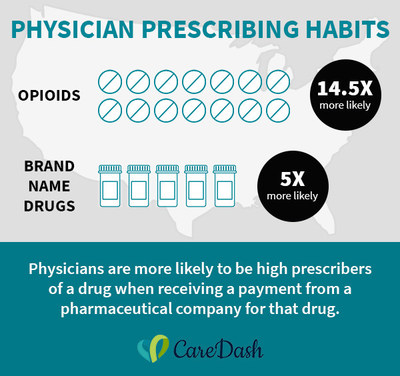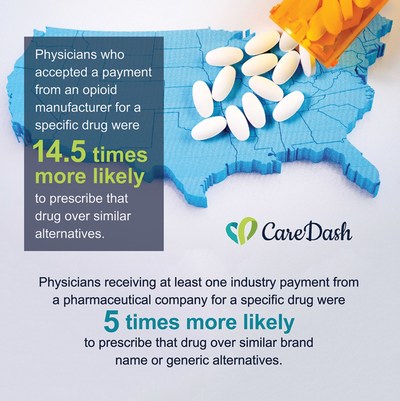New Analysis Reveals Links Between Payments from Opioid Manufacturers and Physician Prescriptions
Report empowers consumers with first-of-its kind transparency on the influence pharma companies may have on patient treatments
CAMBRIDGE, Mass., March 15, 2018 /PRNewswire/ -- Today a new analysis of government data made available to consumers for the first time by CareDash.com reveals the relationship between payments made by pharmaceutical companies to physicians, the number of prescriptions arising from physicians who received those payments, and the cost and consequences to consumers as a result.


"Possible Side Effects: Investigating the Connection Between Payments from Pharmaceutical Companies and the Prescribing Habits of Physicians" found that physicians who accepted a payment from a pharmaceutical company manufacturer related to a specific opioid drug were 14.5 times more likely to prescribe that drug over a similar alternative. The larger study results also found that physicians receiving at least one industry payment from a pharmaceutical company for any specific brand-name drug were five (5) times more likely to prescribe that drug over alternatives, including lower cost generic drugs. Between 2014 and 2016, physicians in the U.S. received a total of $6.2 billion in payments from pharmaceutical companies.
"This study reaffirms the potential influence pharmaceutical companies have on physician prescribing practices, which can lead to possible risks for patients," said Dr. Aaron S. Kesselheim, M.D., J.D., an associate professor of medicine at Harvard Medical School/Brigham and Women's Hospital and leading global expert on bioethics, pharmaceutical law, and regulatory policies, who reviewed the study methodology and results. "The results demonstrate the importance of measures to improve transparency of these payments, such as the Physician Payments Sunshine Act of 2010, and the need to ensure that physicians have access to reliable, non-industry-sponsored sources of drug information that can maximize evidence-based prescribing practices."
"This analysis pulls back the curtain on the influence pharmaceutical companies may have on a patient's course of treatment and allows patients to make more informed healthcare choices," said Ted Chan, Founder and CEO of CareDash, the healthcare provider review site dedicated to transparency. "Patients have the right to know about their doctors' motivations, any potential conflicts of interest, and should be aware of the connection between the marketing practices of pharmaceutical manufacturers and the drugs they are prescribed by their physician. With this information, patients can feel empowered to ask and fully understand their options, whether that be an alternative branded prescription or a more cost-effective generic."
Prescription drug spending in the U.S. comprised about 17-20% of all healthcare spending and invoice spending on medicines is expected to reach $580B-$610B by 2021. The vast majority of this cost comes from brand-name prescription drugs. A 2016 study found that brand-name drugs account for 72% of total drug spending despite comprising just 10% of all prescriptions. Additionally, a 2017 study, "Public Awareness of and Contact With Physicians Who Receive Industry Payments: A National Survey," found that 65% of patients had seen a physician who received payments over the previous 12 months, but only 5% of patients were aware of that fact.
"Possible Side Effects: Investigating the Connection Between Payments from Pharmaceutical Companies and the Prescribing Habits of Physicians" Key Findings
Overall Findings
- Physicians were 5.3 times more likely to prescribe a brand-name drug over alternatives in 2015 when they received a payment related to that drug in 2014
- Physicians were 5.5 times more likely to receive a payment on behalf of a drug in 2016 after high rates of prescribing the drug in 2015. Payment values to individual physicians ranged from $0 to $58.4 million
- There are prescribing differences among medical specialties, with some specialties being more likely to prescribe a drug over alternatives when receiving a payment:
- Family Practice 5.6 times
- Internal Medicine 4.3 times
- Psychiatry 3.9 times
- Cardiology 2.8 times
Drug and Pharmaceutical Company Findings
- Physicians in California received the highest average number of payments per year from pharmaceutical companies from 2014 to 2016: 1.2 million payments total
- The top drugs physicians received payments for in 2014 to 2016 paid by individual companies were:
- Xarelto $76.5 million paid by Janssen Pharmaceuticals
- Invokana $55.9 million paid by Janssen Pharmaceuticals
- Humira $53.0 million paid by AbbVie Inc.
- The top payment categories from pharmaceutical companies to physicians for 2016 include:
- Promotional speaking or service $561.9 million
- Royalty or license $490.4 million
- Consulting $366.3 million
- The top payers to physicians in 2014 to 2016 were:
- Janssen $197.6 million for drugs including Xarelto, Invokana, and Stelara
- AstraZeneca $167.3 million for drugs including Bydureon, Brilinta and Farxiga
- Allergan $136.5 million for drugs including Botox, Restasis and Linzess
- Physicians who receive payments for Synthroid are 2.6 times more likely to be high-prescribers of the drug
Opioid-Related Findings
- Opioid manufacturers spent more than $43 million in payments for physicians from 2014 to 2016
- More than $27 million were promotional speaking or service payments
- More than $8.5 million were food and beverage payments
- The top opioid manufacturers providing payment to physicians were:
- INSYS Therapeutics, Inc. $16.0 million
- Purdue Pharma L.P. $11.5 million
- Depomed, Inc. $5.7 million
- Pfizer, Inc. $2.2 million
- There were 74,272 payments on behalf of Subsys, an opioid drug from INSYS Therapeutics, Inc. between 2014 and 2016, totaling $16 million
- There were 6,501 payments made by opioid manufacturers to 997 physicians in Massachusetts between 2014 and 2016
- On average, physicians in Florida, California, Ohio, Arizona, Texas and New York accepted more payments from opioid manufacturers than those from other states
- Of these states and according to the data in Open Payments, New York physicians received the highest average amount of payments on behalf of opioids: $1,014.93 per provider
- Physicians in California received more than $5.4 million in total payments on behalf of opioids from 2014 to 2016
"Possible Side Effects: Investigating the Connection Between Payments from Pharmaceutical Companies and the Prescribing Habits of Physicians" cross-links Open Payments data from 2014 through 2016, available to the public via the Centers for Medicare and Medicaid Services, with Medicare Part D prescription data. The data, released June 30, 2017, represent the largest and most recent data sets available, which CareDash used to analyze prescribing trends associated with financial relationships. The report builds on previous research, mainly from ProPublica, which released a report in March 2016 investigating the correlation between payments from all drug and device companies and providers' prescribing habits across the broad labels of brand-name and generic drugs. In addition to using more recent data, CareDash took the available research one step further by investigating the granular relationship between payments made by individual companies for specific drugs and the prescribing habits of the recipient physicians for those drugs. The study is also one of the first to look at prescriptions preceding and following payments.
In December 2017, CareDash announced a first-of-its kind enhancement of its individual provider listings to show the amount and type of payments coming from pharmaceutical and medical device companies, as well as the amounts from specific companies for specific drugs and medical devices. The Centers for Medicare and Medicaid classify a "payment" as money paid for categories such as entertainment, consulting fees, travel and lodging, education, and food and beverage.
To review the complete report, visit https://www.caredash.com/openpayments.
To search for a specific provider's payments data, visit https://www.caredash.com; to see an example of a provider profile, click here.
About CareDash
Headquartered in Cambridge, MA, CareDash.com is an online healthcare portal transforming the doctor review industry to make it more transparent and accessible for all patients regardless of their socio-economic background. CareDash provides a centralized location for patients to share their experiences and learn about the healthcare industry through trusted reviews and information. CareDash provides an unbiased look at available data and is a trusted resource that will help people choose the right provider for them. CareDash services more patients in the low-to-middle income range than leading patient review sites – many of whom have traditionally been ignored and underrepresented in this space. For more information about CareDash, please visit https://www.caredash.com.
SOURCE CareDash
Related Links
WANT YOUR COMPANY'S NEWS FEATURED ON PRNEWSWIRE.COM?
Newsrooms &
Influencers
Digital Media
Outlets
Journalists
Opted In
Share this article